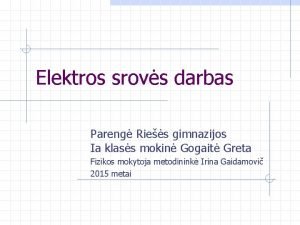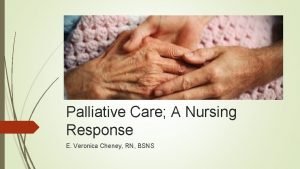Reducing Distracted Medication Errors MWH Oncology and Hospice

- Slides: 1

Reducing Distracted Medication Errors MWH Oncology and Hospice Unit Allison Slocum MEDICATION ADMINISTRATION ERRORS (MAEs) Identifying The Problem • Self-observation while passing medications alongside my preceptor and safety huddle concerns • Common distractions: telephones, physicians, other nurses, loud noises and alarms Problem • MAE: most common are missed doses, incorrect patient, and incorrect dose of the correct medication • Currently NIZs often disregarded • Most common reported mistakes within the nursing field are those related to medication administration errors • MEAs in the U. S. cost health care systems $380 million annually, 1. 5 million patients negatively affected • A nurse is twice as likely to make a mistake while administrating medication if he or she is distracted • 3 rd most common sentinel events in the U. S. are MAEs • Rapid Cycle Tests (RCTs): • Practiced in hopes of reaching a faster and more effective approach to change • Use of do not disturb signs • 3 week observational period: proved decrease in medication errors but also RNs reported greater time availability throughout their shift • Indirect results of informational signs: less conversational distractions, decrease in personal conversation distractions, decrease in outside conversation volume and overall noise level on the unit • No decrease in physician-related distractions • 2017 Study on Medical Surgical Floor: implemented use of safety vests and informational signs • Noticed a 88% drop in MEAs due to the safety vests alone • 82% of RNs reported success within signs that read “Do Not Disturb The Nurse During Medication Administration”, signs remained after change period • 2017 Study in Kentucky: intervened also with noise reducing headset • Most nurses reported that they don’t feel distracted while passing medications • Observational study observed 149 instances of some sort of distraction or potential for during a 2 month period • Nurses were less visibly distracted • Outline 4 different types of distraction: potential distraction, intentional potential distraction, unintentional potential distraction, and visibly distracted • Intentional distractions reduced from 39% to 21% following changes on the unit RESEARCH POSTER PRESENTATION DESIGN © 2015 www. Poster. Presentations. com Change theory: • Can be defined as the structure for administrating, adhering to, and reflect on interventions for change • Revolve around a similar dynamic and unending process of unfreezing, moving, and refreezing • Important for the continued success of the field of nursing and best patient care outcomes • Common included variables: health care expenses, clinical patient populations, nursing staff, physicians, other health care professionals, retention of staff, patient satisfaction regarding the health care organization and staff Spread The Word/Facts/Disseminate information • Mandatory staff education sessions: for all hospital personnel and health care professionals • Pamphlets for patients and visitors • Community informational sessions • Conduct organized and methodological studies throughout • More published literature review across U. S. patient populations and health care settings PHASE Public Knowledge and Awareness of Safe Medication Administration Errors SOLUTION Literature Review LIPPITTS SEVEN PHASES OF CHANGE THEORY PLAN: • Safety vests to be worn by nurses engaging in passing medications • Headsets serve versatility to prevent auditory stimuli and also discouraging intentional distractions • Pamphlets in the rooms so visitors have access to this education regarding the subject, enforce the severity • Review progress in safety huddles, converse about new ideas, things that have improved, what can be improved, etc • Every nurse, every doctor, every administrator has a boss, accountability must be shown at all levels in order for an effective change to be achieved 1: DIAGNOSE THE PROBLEM Recognize incidences of MAEs related to environmental distractions and distribute plan to staff. 2: ASSESS MOTIVATION AND CAPACITY FOR CHANGE Address staff concerns regarding plan, survey current attitudes towards the problem, recognizing that people will be resistant, and enforcing at least an attempts from all individuals for the change. Suggest motivating factors for change such as increased time for patient care. 3: ASSESS CHANGE AGENTS MOTIVATION AND RESOURCES Nurse managers, nursing staff, physicians, hospital personell, and patients and their families are all change agents necessary to promote the greatest change in reducing medication errors from distractions. 4: SELECT PROGRESSIVE CHANGE OBJECTIVE Concrete plan an protocol for implementation of signage, medication vests, educational courses, and soundreducing head sets on the unit. 5: CHOOSE APPROPRIATE ROLE OF CHANGE AGENT Management and nursing staff held accountable through necessary observational studies and notifying staff that they are being monitored in regards to their adherance to procedures. 6: MAINTAIN CHANGE Post-interventional surveys, enforcing the use of successful interventions from the change phase, and ongoing observational studies to monitor progress. 7: TERMINATE THE HELPING RELATIONSHIP Conclusion/Moving Forward/Summarization • Conditioning: overtime people would automatically understand the severity of interrupting nurses during medication administration and be able to more clearly recognize that a nurse is passing medications • Remain understanding that not everyone will be as motivated to follow through with change, provide constant positive re-assurance and motivation for all staff as the project manager Administration To Monitor and Enforce Protocol Reduce External Distractions Eventual conditioning of the change agents will hopefully result in long term change. For example, vests will no longer be necessary as people will pay more attention and respect that a nurse is preparing medication Barriers To Change • Safety vests only effective if others respect their use • Ineffective location or size of signs (should be in patients rooms, near NIZs and other common areas such as waiting rooms or hallways) • Not remembering to apply safety vest prior to MA • Nurses abuse the safety vest when not administering medication, in which the vests would eventually be ignored and lose purpose over time • Gap in public knowledge and awareness of the issue • Physicians or other health care professionals who are low on time or patience and disregard the interventions (i. e. signs and vests) • Telephones • Lack of retention of nurses, less to train new graduates • Nature of medication administration, standing still, appears free • Lack of communication between interdisciplinary health care team Addressing Possible Resistance to Change • Remind nursing staff that the use of resources in the plan such as safety vest will be monitored by administration • Follow protocol for violators • Encourage those most likely to be resistant to change with incentives such as more time to care for patient loads and greater protection of RN licensures • Ensuring that change is inexpensive, and will also save money for institutions Safer Medication Administration Education To Emphasize The Problem References Feleke, S. A. , Mulatu, M. A. , & Yesmaw, Y. S. (2015). Medication administration error: magnitude and associated factors among nurses in Ethiopia. BMC Nursing, 141 -8. doi: 10. 1186/s 12912 -015 -0099 -1 Mcauley, L. , Schlaug, A. , & Ackemann, E. (2017). Tuning Out the Distractions. Kentucky Nurse, 65(4), 7. Mitchell, G. (2013, February 4). Selecting The Best Theory To Implement Planned Change. Retrieved March 30, 2018. Pape, T. , Guerra, D. , Muzquiz, M. , Bryant, J. , Ingram, M. , Schranner, B. , &. . . Welker, J. (2005). Innovative approaches to reducing nurses' distractions during medication administration. Journal Of Continuing Education In Nursing, 36(3), 108 -142. Tompkins Mc. Mahon, J. (2017). Improving Medication Administration Safety in the Clinical Environment. MEDSURG Nursing, 26(6), 374 -409. Wolak, E. (2017). A Novel Approach to Reducing RN Distraction During Medication Access. MEDSURG Nursing, 26(2), 93 -98.

